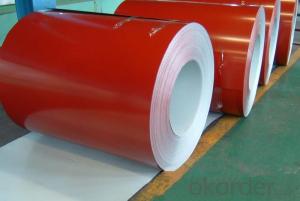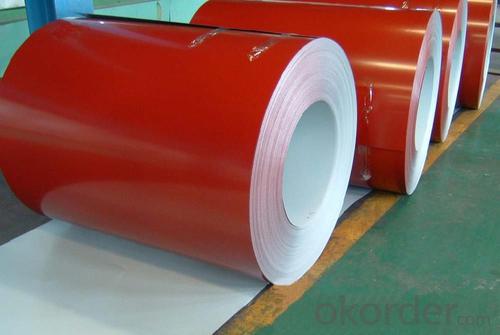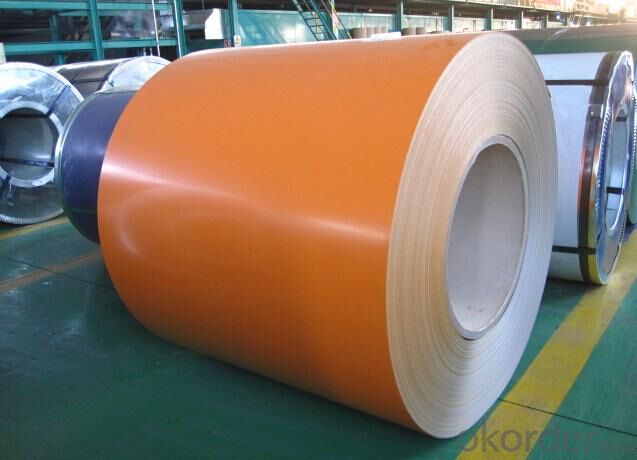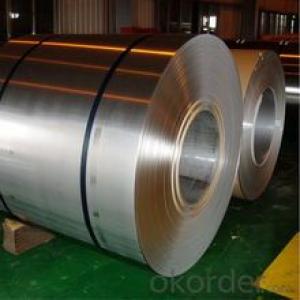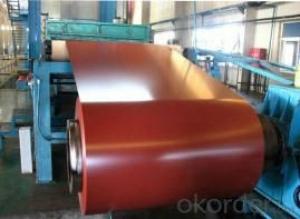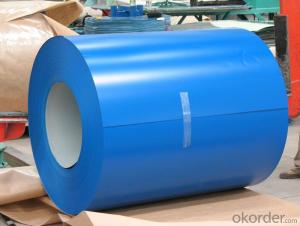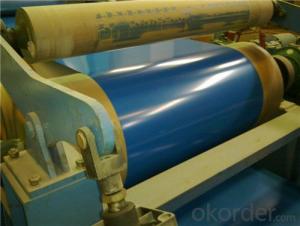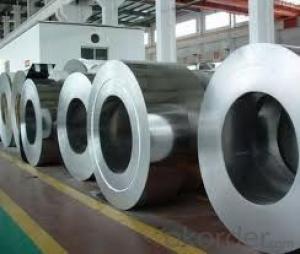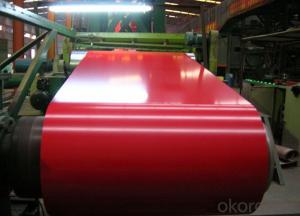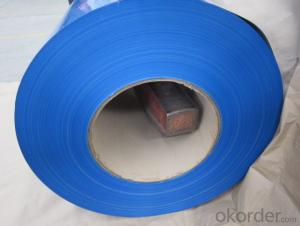Color Coated Galvanized Steel Coil in High Quality
- Loading Port:
- Tianjin
- Payment Terms:
- TT OR LC
- Min Order Qty:
- 50 m.t.
- Supply Capability:
- 10000 m.t./month
OKorder Service Pledge
OKorder Financial Service
You Might Also Like
1. Pre-Painted Galvanized/Aluzinc Steel Coil Description:
With GI as base material, after pretreatment (degrease and chemical treatment ) and liquid dope with several layers of color, then after firing and cooling, finally the plate steel is called pre-painted galvanized (aluzinc) steel. Pre-painted galvanized steel is good capable of decoration, molding, corrosion resistance. It generally displays superior workability, durability and weather resistance.
2.Main Features of the Pre-Painted Galvanized/Aluzinc Steel Coil:
• Excellent process capability
• Smooth and flat surface
• Workability, durability
• Excellent heat resistance performance
• High strength
• Good formability
• Good visual effect
3.Pre-Painted Galvanized/Aluzinc Steel Coil Images
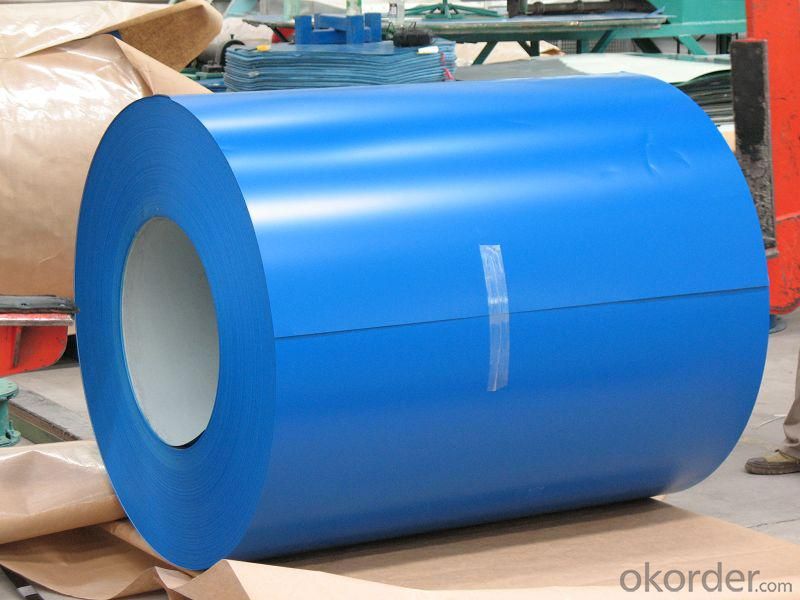
4.Pre-Painted Galvanized/Aluzinc Steel Coil Specification
Standard: AISI, ASTM, BS, DIN, GB, JIS
Grade: DX51D, DX52D
Thickness: 0.17-2.0mm
Brand Name: KMRLON
Model Number: coil
Type: Steel Coil
Technique: Cold Rolled
Surface Treatment: Coated
Application: Boiler Plate
Special Use: High-strength Steel Plate
Width: 20-1250mm
Length: customized
commoidty: pre-painted galvanized steel coil
Thickness: 0.13-4.0mm
width: 20-1250mm
zinc coating: 40-180g/m2
printing thickness: top side: 20+/-5 microns, back side: 5-7 microns
color: all RAL color
surface treatment: color coated
coil weight: 4-7 tons
coil ID: 508/610mm
packaging: standard seaworthy packing
5.FAQ of Pre-Painted Galvanized/Aluzinc Steel Coil
1. What’s the application of this product?
Roof, roof structure, surface sheet of balcony, frame of window, etc.
2. What’s the brand of the paint?
We use the best brand of all of the word—AKZO.
3. How about your company?
A world class manufacturer & supplier of castings forging in carbon steel and alloy steel,is one of the large-scale professional investment casting production bases in China,consisting of both casting foundry forging and machining factory. Annually more than 8000 tons Precision casting and forging parts are exported to markets in Europe,America and Japan. OEM casting and forging service available according to customer’s requirements.
4. How to guarantee the quality of the products?
We have established the international advanced quality management system,every link from raw material to final product we have strict quality test;We resolutely put an end to unqualified products flowing into the market. At the same time, we will provide necessary follow-up service assurance.
5. How long can we receive the product after purchase?
Usually within thirty working days after receiving buyer’s advance payment or LC. We will arrange the factory manufacturing as soon as possible. The cargo readiness usually takes 15-25 days, but the shipment will depend on the vessel situation.
- Q: I was reading about the Colt 38 Super Custom and it said it's optional between a carbon steel frame or a stainless steel frame. What is the difference? There is also a choice between aluminium or stainless steel hammers and triggers can you also tell me the difference between them please?
- Carbon steel is harder but does not resist corrision as well. It really depend on the grade. Like 440A is crap and 440C is much better. Aluminum would be the way to go. It is lighter and just as if not stronger. Some people will be die hards when it comes to either metal. I don;t know much about the guns. I know plenty about different grades of sttel when I collected swords and knives.
- Q: What are the dimensions of steel coils used in the appliance industry?
- The dimensions of steel coils used in the appliance industry can vary depending on the specific application and requirements. However, the most common dimensions for steel coils used in the appliance industry are typically around 0.015 to 0.035 inches (0.38 to 0.89 millimeters) in thickness, 24 to 36 inches (61 to 91 centimeters) in width, and weighing between 1,500 to 10,000 pounds (680 to 4,535 kilograms). These dimensions allow for efficient handling, transportation, and processing of the steel coils in the appliance manufacturing process. It is important to note that these dimensions can vary and should be confirmed with the specific manufacturer or supplier for accurate and up-to-date information.
- Q: What are the different types of steel coil storage racks?
- There are several different types of steel coil storage racks, including coil cradles, coil saddles, coil blocks, and coil storage bins. Each type is designed to safely and efficiently store steel coils based on their size, weight, and specific requirements.
- Q: What are the dimensions of steel coils?
- The dimensions of steel coils vary depending on factors such as the specific type of steel, the intended use, and industry standards. Generally, steel coils can range in width from a few inches to several feet, with thicknesses typically ranging from a fraction of an inch to several millimeters. The inner diameter of a steel coil can also vary, with common sizes being 20 inches and 24 inches. Ultimately, the dimensions of steel coils are determined by the specific needs and requirements of the end user.
- Q: I want to buy steel. My problem is i purchase it from a middle man, so i need to know what MIld steel is. What it's real name or specifications is/are. I dont want to end up purchasing Black steel or other stuff i can sell or use...
- Mild okorder /... Seamless usually refers to a method for making tubing, as opposed to the alloy of steel. Seamless tubing is usually drawn, rather than made from a sheet welded into the form of a tube.
- Q: Are steel coils used in electrical equipment manufacturing?
- Yes, steel coils are commonly used in electrical equipment manufacturing. They are often used in the construction of transformers, motors, generators, and other electrical devices. The steel coils provide structural support, magnetic properties, and efficient conduction of electricity, making them an essential component in electrical equipment manufacturing.
- Q: How are steel coils used in the manufacturing of storage cabinets?
- Steel coils are used in the manufacturing of storage cabinets as they are processed and shaped into sheets or panels, which are then cut, formed, and assembled to create the structural framework and outer shell of the cabinets. The steel coils provide strength, durability, and rigidity to the cabinets, ensuring their ability to withstand heavy loads and provide long-lasting storage solutions.
- Q: What is the maximum length of a steel coil?
- The maximum length of a steel coil can vary depending on various factors such as the type of steel, manufacturing capabilities, and transportation logistics. However, in general, steel coils can be several hundred meters long, with some specialty coils exceeding a kilometer in length.
- Q: How are steel coils used in the production of electrical enclosures?
- Steel coils are used in the production of electrical enclosures as they are formed and shaped into various components such as panels, frames, and doors. These coils are typically cut, stamped, and bent to the required dimensions, providing the necessary strength and durability for the enclosures. Additionally, steel coils can be coated or painted to enhance their resistance to corrosion and improve the overall aesthetics of the electrical enclosure.
- Q: So I want to get my 3+ wood shafted with a dynamic gold shaft because i need a stiffer shaft but dont want to spend much on it.I've never swung a steel shafted wood, but I hear that it is more consistent that graphite....Plus, since the cost of steel is only $15 compared to the $65 graphite, not to mention installation charges.So yeah...... How good is steel for fairway woods?BTW, my swing speed is about 95 but i can amp it up to 110 (with control, that is)
- There are very few people who hit steel shafted fairway woods. Tiger Woods used to have a steel shafted 3 wood but went to graphite because it didn't feel right because of his driver. Go get custom fit for a shaft and see if a steel shaft is good to make sure because you don't want to turn aroung a get a graphite shaft anyway if the steel shaft doesn't work. Go with whatg works the first time so you don't put out more money later.
Send your message to us
Color Coated Galvanized Steel Coil in High Quality
- Loading Port:
- Tianjin
- Payment Terms:
- TT OR LC
- Min Order Qty:
- 50 m.t.
- Supply Capability:
- 10000 m.t./month
OKorder Service Pledge
OKorder Financial Service
Similar products
Hot products
Hot Searches
Related keywords
